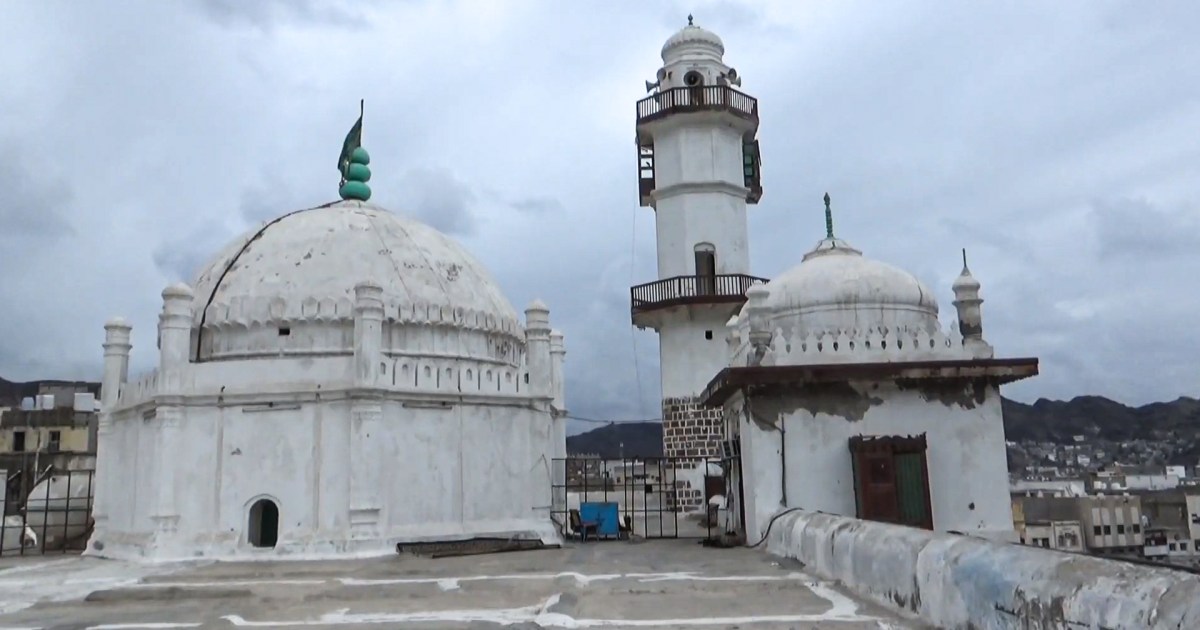Al-Aidarous Mosque in Yemen - one of the most famous monuments in Aden - is facing the threat of collapse due to neglect and the erosion factors that have been evacuated in the body of this archaeological building over decades, to become another of Yemen's landmarks threatened with loss in a war-torn country.
The mosque stands on a small hill under the foot of a mountain in the town of Crater (the oldest town in Aden), and is known for its white color and its distinctive shape domes, dating back more than 500 years, and for its historical position, its image was used on some postage stamps of ancient Aden.
Mayday calls
Lately, distress calls have been made to international organizations to speed up the rescue of this historic landmark, which is at a dangerous and bad juncture as a result of the war conditions that made the authorities face difficulties in raising the necessary funds for the maintenance of archaeological sites in the country.
Ramses Hussam El-Din - who is in charge of the mosque - warned that the building is in danger and is liable to collapse on the heads of the worshipers at any moment in case the restoration is not responded to quickly. He said, "He has contacted international organizations to restore it, but he has not found a response yet."
He added to Al-Jazeera Net that "the building suffers from many cracks and cracks in the walls and ceilings, and these cracks are expanding and worsening day after day as a result of the erosion of the wood carrying the roof by wood worm and the factors of time, rain and heat."
Al-Aidarous Mosque is one of the most famous and important archaeological mosques and religious schools in Aden, and it is visited by many tourists who visit the city, and it was an important stronghold of the Sufi community in Yemen and a destination for many students of knowledge from Yemen and the countries of East Asia and Africa for 6 continuous centuries.
The mosque is distinguished by its design in the Indian style, and it is considered one of the Yemeni mosques with colonnades of many colonnades, and there is no central courtyard, and its construction dates back to the year 1484 (899 AH), according to the head of the history department at the Cultural Creativity Center in Aden, Abdul Qadir al-Hout al-Mihdhar.
The mosque is attributed to the name of the person who supervised its construction, which is Abu Bakr bin Abdullah Al Aidarous, one of the most prominent Sufi sheikhs in Yemen. He came to Aden from the city of Tarim in Hadramout, and his first work was to build this mosque and make it a place for teaching, discussion and study of science. And his grave is to the north of the mosque.
The mosque consists of a large hall in which prayer takes place and another part dedicated to ablution, in addition to wings and annexes to accommodate students of knowledge, and its ceiling is topped by a large dome covering a square room that contains inside it wooden coffins that are the graves and mausoleums of Imam Aidaroos and members of his family.
Despite the passage of about 560 years, many residents of Aden still commemorate the arrival of this world to it through an annual celebration every year in which the mosque is visited, the streets and neighborhoods leading to it are decorated and lit, and sweets, dates and gifts are distributed to visitors.
Obliteration of identity
Al-Mihdhar points out that the mosque was initially a small mosque, then it was rebuilt in 1519 (925 AH), and its architecture was renewed more than once during the 11th and 12th centuries, the last of which was in the middle of the 13th century.
He added to Al-Jazeera Net that "the last expansion of the mosque was at the end of the 14th century AH, as was the last restoration process in 1413 AH, in which the bond of Islamic education was added."
Valentina Abdul Karim Mahdi, a member of the local council of Al-Mualla District in Aden, describes Al-Aidarous Mosque as one of the main components of the city's cultural identity, and it is one of the archaeological monuments that are threatened with disappearing and vanishing as a result of neglect and lack of maintenance.
In an interview with Al-Jazeera Net, she warned of the operations of bulldozing and obliterating the identity of Aden's landmarks, and said that several archaeological sites in Aden have recently suffered severe damage due to neglect and random urban activity, and some of them were destroyed during the recent war on Aden.

